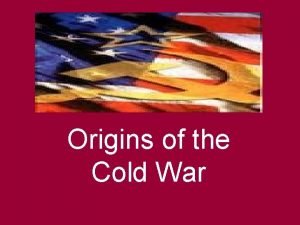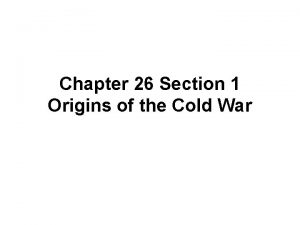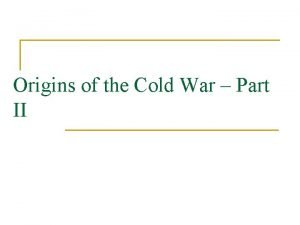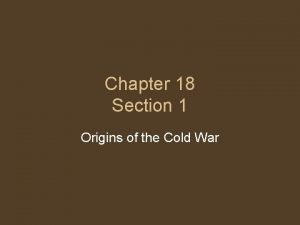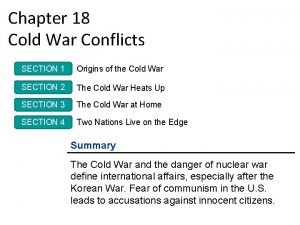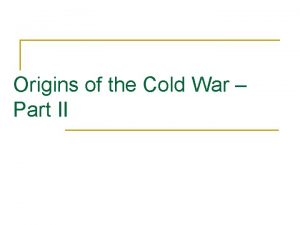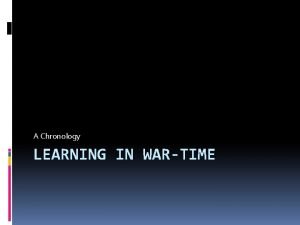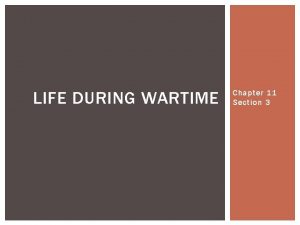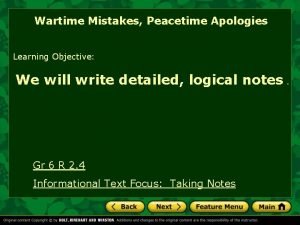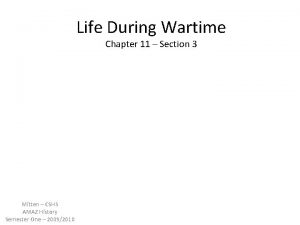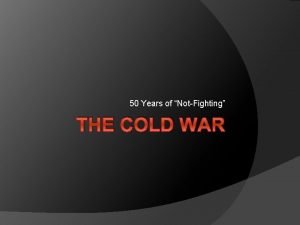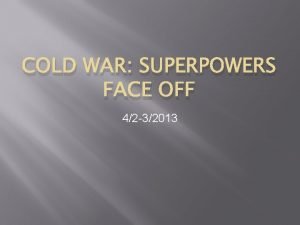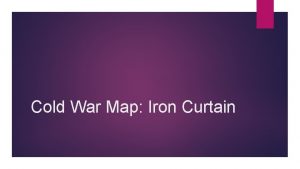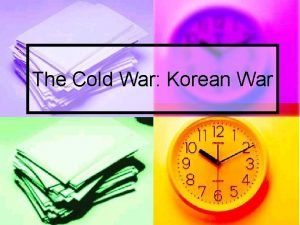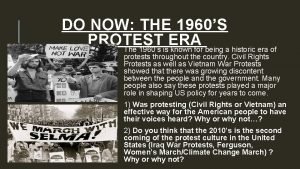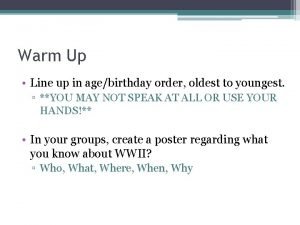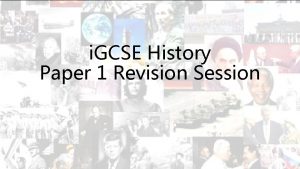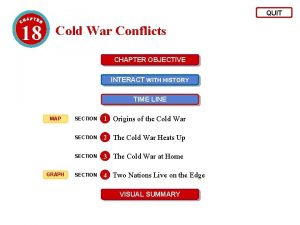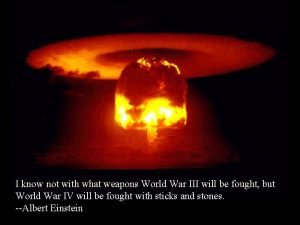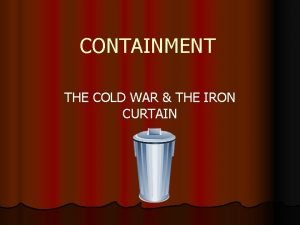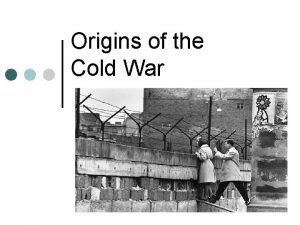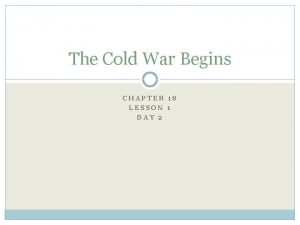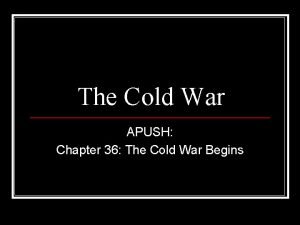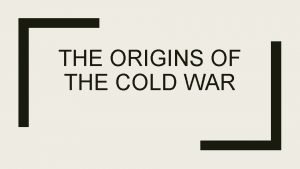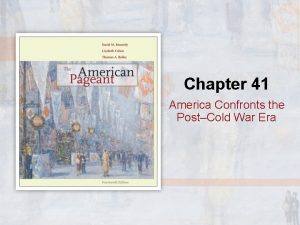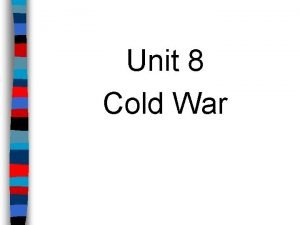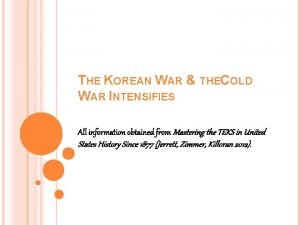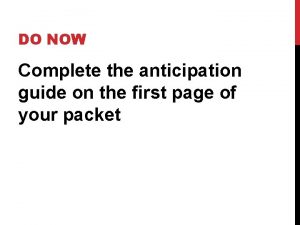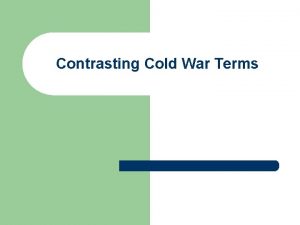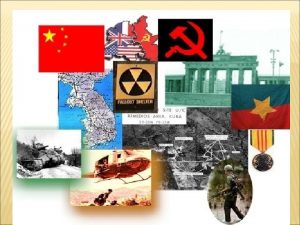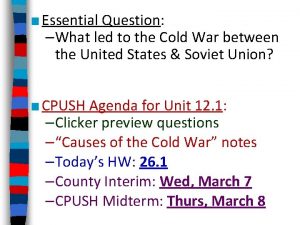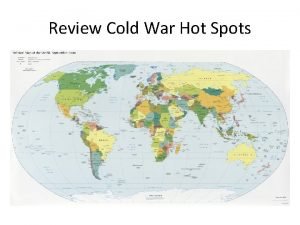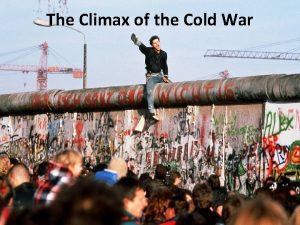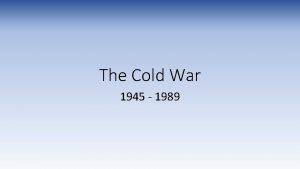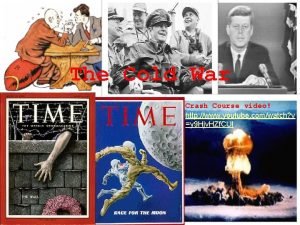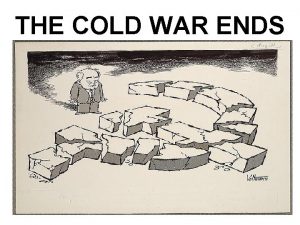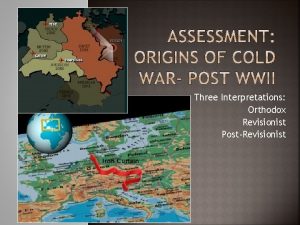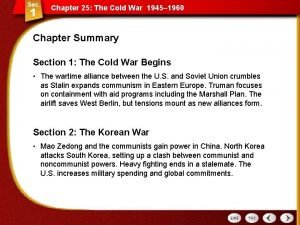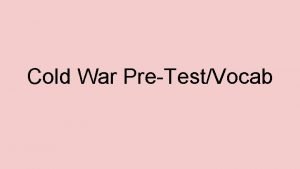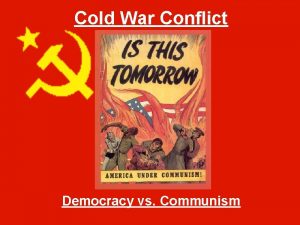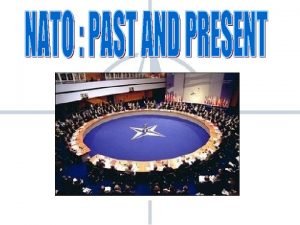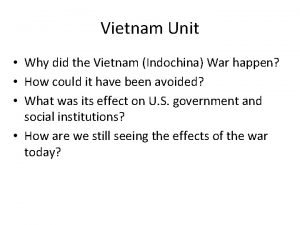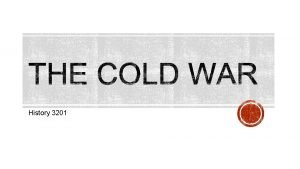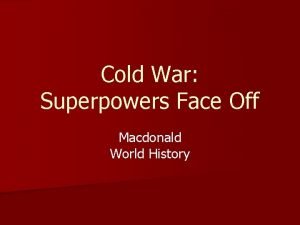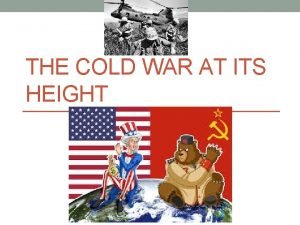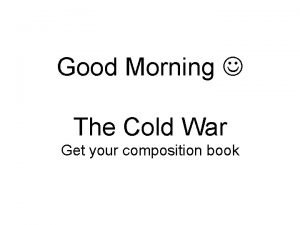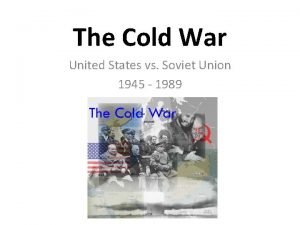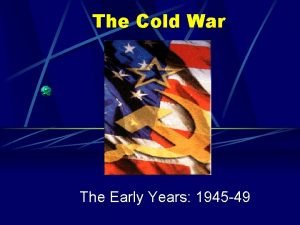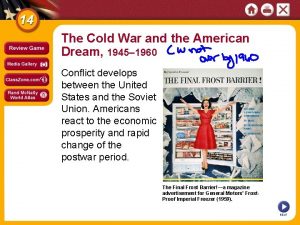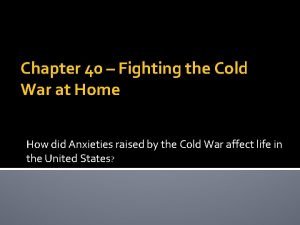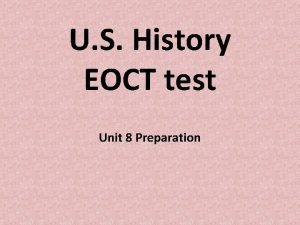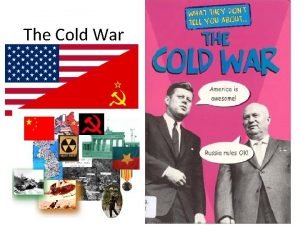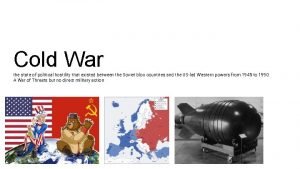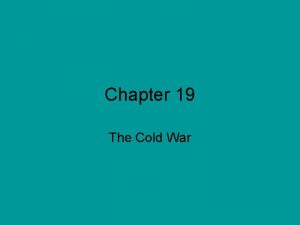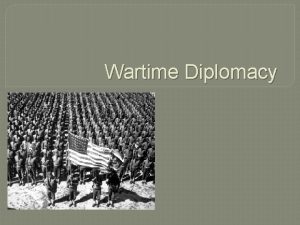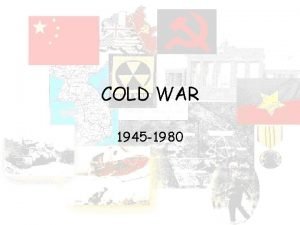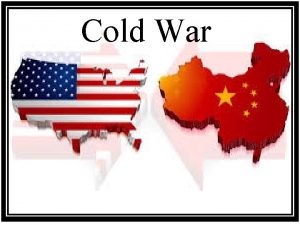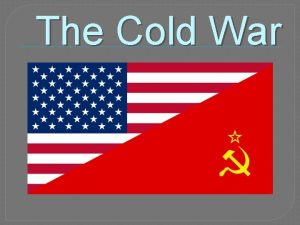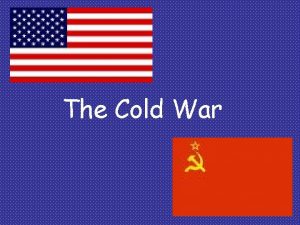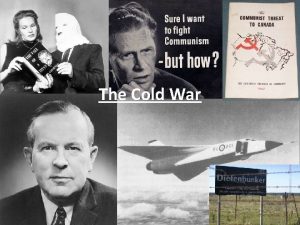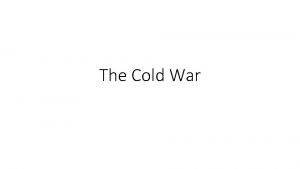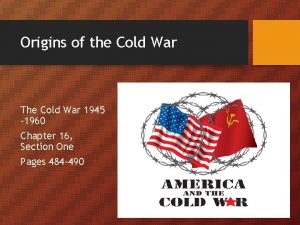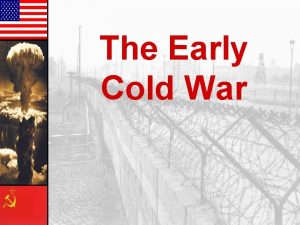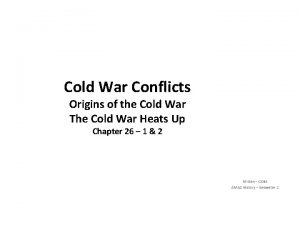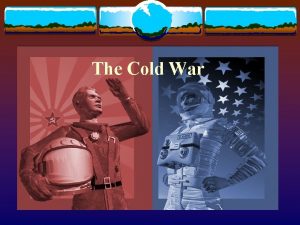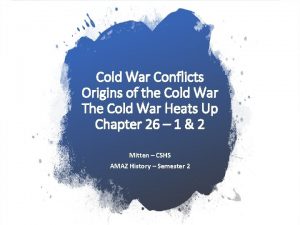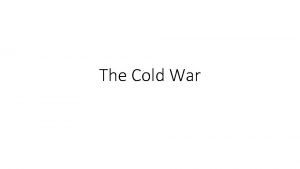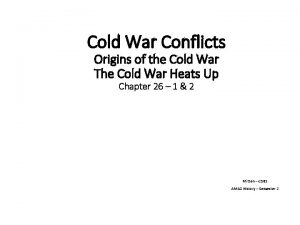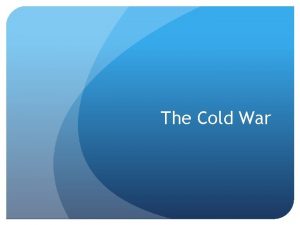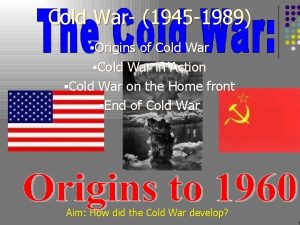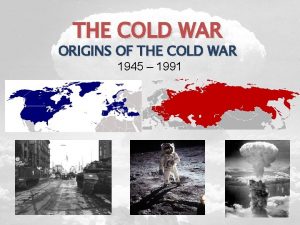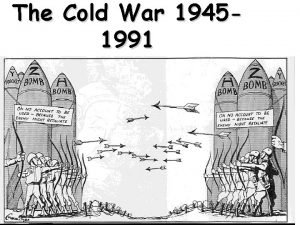Origins of the Cold War A Wartime Alliance
































































- Slides: 64

Origins of the Cold War

A Wartime Alliance Begins to Erode What visions did the US and USSR have for postwar Europe?

Soviet Union • Security fueled Stalin’s decisions. Germany had attacked the USSR, so he wanted to create a friendly buffer zone of friendly communist states to protect them. • Stalin wanted the USSR to have a sphere of influence in Eastern Europe for protection.

United States • President Truman (US) wanted to allow Eastern Europe nations to determine their own form of government. Given that free choice, he hoped they would pick Democracy (free elections).

What were the wartime experiences of each country? Soviet Union (USSR): • 20 million citizens, 7 million soldiers died. • Many died of disease and hunger or killed in German labor camps. • Crops, farm animals and equipment was all destroyed by the Nazis. • Cities were leveled.

US: • Suffered far less than USSR • 290, 000 soldiers died, very limited civilian casualties (Pearl Harbor). • No battles on US soil (except Pearl Harbor). • US economy boomed during the war.

What Ideologies Shape Each Country? USSR: • Believed in communism because capitalism produces social inequalities, denies the working class (proletariats) a fair share of the nation’s wealth. • Communism revolves around single party rule of politics and economy.

US: • Believed in democratic government. • Capitalist economy (private ownership of businesses and services)

How did the Superpowers view each other? Why was the conflict frightening? • The USSR and USA both believed their forms of government and economic systems were superior • The conflict became frightening as both countries began developing weapons of mass destruction.

How did the USSR respond? • Stalin denounced capitalism, publicly stated that peace would never exist.

What was the US’s plan to control nuclear weapons? • The US believed that a policy of containment was necessary (communism must not spread). • The US encouraged to United Nations (UN) to enact strict controls on raw materials used in bomb making and a plan on making a ban on the making of any future bombs. This also called for UN inspections of nuclear power plants and facilities.



What was the Soviet Union doing in Eastern Europe? • The USSR was a dominate influence in Eastern Europe. The Iron Curtain formeddividing Eastern and Western Europe. • Communist leaders came to power in Eastern European countries with the help of secret police (USSR) to silent all opposition.

Why would the US be concerned about Greece? • Communist rebels wanted to take over the democratic Greek government to get important shipping areas (channels)

How did the US respond to the Communist threats? • Truman advocated containing communism (Truman Doctrine). • Sent US aid to the Greek government to defeat the rebels. • Congress passed the National Security Act (NSC) and the Central Intelligence Agency (CIA)

How did the Soviets view the US and its allies? • The Soviets viewed the US as hostile powers committed to destroying communism and threatening Soviet security. • They viewed efforts to restrict nuclear weapons as a way to maintain a US monopoly on them.

What were the conditions in Europe after the war? After the war Europe was in shambles. Cities were destroyed and countries were bankrupt. Many countries were short on food, fuel and electricity.

What fears did the US have these conditions? US leaders feared that the conditions in Europe would lead to political and social unrest. Communism became appealing to many who were suffering from difficult times.

What plan did the US propose for European recovery? The Marshall Plan (Sec of State George Marshall): Offer all European countries (including the USSR) generous funding to rebuild their economies as long as the money was spent on goods from the US.

How did the Soviets respond to the plan? USSR responded with the Molotov Plan designed to aid economic recovery in Eastern Europe.

• During the Cold War much of Europe became divided. The United States and the Soviet Union waged a war of words, using propaganda, diplomacy, economic and military aid and espionage (spying) as weapons.

The Cold War Expands Chapter 39

U-2 Incident • On May 1, 1960, the Soviets shot down a U. S. spy plane over the USSR. • The plane was a U-2, a highaltitude, black aircraft known as the ‘Black Lady of Espionage. ’ • The ‘U-2 Incident’ enraged Soviet leaders and caused a further chilling in US-Soviet relations.

Berlin Blockade The Soviet Union imposed a blockade of Berlin, halting all land travel from Allied occupational zones. The Soviets believed that the blockade would force the Allies to give up Berlin or plans for a West German state.

Berlin Airlift President Truman ordered a massive airlift. 270, 000 flights into West Berlin, delivering over 2. 5 million tons of supplies! Success! The Soviets ended the blockade and Berlin was divided, along with the rest of the country-East and West.

Coup d'état in Czechoslovakia! Stalin amassed Soviet troops on the Czech border and demanded the formation of an all-communist government. This ‘sudden government’ turnover alarmed Truman. In Czechoslovakia life drastically changed as noncommunists were jailed and freedoms were taken away.

The coup d'état (sudden government take over) in Czechoslovakia showed that Stalin would nnot accept government in which power was shared with noncommunist's and was prepared to use force.

Satellite Nations • In the late 1940 s the USSR tightened its grip on its satellite nations, or nations under one country’s control.

NATO-Alliance • Stands for ‘North Atlantic Treaty Organization. ’ • Founding members were the US, Canada, France, Luxembourg, Belgium, the Netherlands, Iceland, Italy, Britain, Denmark, Norway, Portugal, Greece, Turkey, and West Germany.

Warsaw Pact The Soviet Union formed its own alliance in 1955. USSR, Albania, Czechoslovakia, East Germany, Hungary, Poland, and Romania.

Hungary test the limits of containment! • In 1956, protesters marched through Budapest waving flags and calling for democracy. • The Soviet Union sent tanks and soldiers to Hungary to kill thousands of protester-the leader of the revolt was put to death, and communist leaders were put back in power.

Cold War in Asia • After WW II, Communists and Nationalists had a civil war in China. In 1949 the communists won, and hopes for a noncommunist ally in Asia fell. • The US feared that China and USSR would form an alliance and pose a great threat to US interests.

The Cold War heats up on the 38 th parallel! • Soviet troops occupied the area to the north of the 38 th parallel and a pro-Soviet communist government came to power. • In the south, US officials supported the existing noncommunist government.


Korean War • The war began when North Korean troop armed with Soviet weapons attacked South Korea. • The UN established a force using troops from 15 different nations. • The final 2 years of the war became a stalemate along the 38 th parallel.

• The DMZ or Demilitarized Zone became the 38 th parallel when the war ended and it established a buffer zone between North and South Korea.

Cold War in the Third World • Third World countries are poor, developing nations in Latin America, Africa, and Asia. • Both the US and USSR used propaganda to exert influence over Third World countries and to persuade them to join their side.

CIA and covert action • Covert action is a secret political, economic or military action that supports foreign policy. • Agents try to shape affairs in foreign countries. • During the Cold War the Superpowers used spies, satellite photography, wiretapping, and other covert methods to have influence in other countries.


When the US found out that the Soviets had an atomic bomb, a deadly arms race followed. Both superpowers developed weapons of even greater destructive force.



The US tried to use a deterrence strategy. This strategy was to develop a weapons arsenal so deadly that the Soviets would not dare attack! Mutual Assured Destruction (MAD) meant is that either side would respond if there was a nuclear attack by launching their own missiles and ensuring total destruction of the other!

SALTStrategic Arms Limitation Talks In 1972 and 1979 negotiations were made where both sides signed treatise setting limits on the numbers of nuclear missiles and launching sites. In the 1980 s, a missile defense system was set up to intercept missiles while they were still in flight.

Nuclear Power in the Age of Terrorism Today more than a half a dozen countries have nuclear weapons or are in the process of developing them. The administration of GW Bush referred to these countries as “rogue states” (or states/countries that have weapons of mass destruction, sponsor terrorism or chemical warfare.

Fighting the Cold War at Home How did the anxieties raised by the Cold War affect life in the United States? Chapter 40

Searching for Communists at Home • In 1951 the gov’t published a pamphlet that listed 100 questions and answers about communism in the US • The US not only fought communism in foreign countries, but also here at home.

Communists Under Suspicion at Home • During the depression, many people were attracted to the idea of communism-some joined the Communist Party. • Communist sympathizers are people who believed in the ideology, but did not join the party.

• As the Cold War heated up, many people grew scared that communists would plot to overthrow the gov’t. • To calm this public anxiety, President Truman established the Federal Employee Loyalty Program. It required federal workers to take a loyalty oath to the US.

HUAC (House Un-American Activities Committee) • HUAC investigated communist influence in the film industry. • The “Hollywood 10” were 10 individuals who refused to answer HUAC’s questions. They argued the 5 th Amendment gave them the right to refuse testimony.

Hollywood Ten Cont. • The committee charged them with contempt of Congress (failure to obey the authority of Congress). • The investigation led studios to make blacklists, or lists of people who had (or were ‘thought’ to have) communist sympathies. If people appeared on the list, they could not find work.

• During the 1950 s Americans became increasingly concerned with espionage (Soviets spying). • A German born physicist named Klaus Fuchs confessed that he had spied for the Soviet Union while working on the Manhattan Project. • From Fuchs, a trail of espionage led investigators to Ethel and Julius Rosenberg.

Rosenberg Trial • The Rosenberg's were charged with passing atomic secrets to the Soviet Union. • Both defendants were sentenced to death. • Many people protested the verdict, contesting the evidence was inconclusive.

(Ethel and Julius Rosenberg)

Joseph Mc. Carthy • Senator Joseph Mc. Carthy gained fame and power by launching a oneman crusade against communist sympathizers in government agencies. • He gained public support and helped Republicans gain control of the Senate in 1952. • Many people were driven out of their jobs because of the accusations made against them.

(Joseph Mc. Carthy)

Mc. Carthyism • The reckless persecution of innocent people became known as Mc. Carthyism. • Today, the term signifies the practice of publicly accusing someone of subversive activities with no evidence to back up changes. • Eventually (1954)Mc. Carthy took his antics too far (accusing the President and the Army of being soft on communism), and faded from the scene.

The Atomic Age • Many novels written in the 1950 s imagined WW III-a conflict fought with weapons powerful enough to destroy all life on Earth. • People had fear of total destruction, however despite these fears many people were excited about nuclear power (for cars, ships, airplanes and power plants).

Federal Civil Defense Admin. • FCDA • Civil defense-organization and training of citizens to work with the armed forces and emergency services during a war or natural disaster. • The agency distributes millions of civil defense manuals to help prepare people for a nuclear attack.

1950’s Bomb Shelter

Civil defense and daily life: • Many communities set up bomb shelters in public buildings. • People kept emergency food and water supplies. • Across the country tests of warning sirens and emergency radio signals were tested every week! • Some families built their own bomb shelter in their backyards.

Children and civil defense • In schools children watched a movie featuring “Bert the Turtle” who taught children to “duck and cover” when an emergency siren sounded.

• Throughout the 1950 s the FCDA repeated operation alerts. • For a growing number of people it became an opportunity to speak out against the nuclear arms race.
 Welcome 1 unit 10 lesson 1
Welcome 1 unit 10 lesson 1 A wartime alliance begins to erode
A wartime alliance begins to erode Chapter 26 section 1 origins of the cold war
Chapter 26 section 1 origins of the cold war Origins of the cold war
Origins of the cold war Origins of the cold war chapter 18 section 1
Origins of the cold war chapter 18 section 1 Origins of the cold war chapter 18 section 1
Origins of the cold war chapter 18 section 1 Origins of the cold war
Origins of the cold war Sides in cold war
Sides in cold war Deqms
Deqms Learning in wartime
Learning in wartime Chapter 11 section 3 life during wartime
Chapter 11 section 3 life during wartime Yoshiko imamoto
Yoshiko imamoto Life during wartime chapter 11 section 3
Life during wartime chapter 11 section 3 Tosconini
Tosconini Guided reading cold war superpowers face off
Guided reading cold war superpowers face off Iron curtain cold war map
Iron curtain cold war map Rollback cold war
Rollback cold war Doves cold war
Doves cold war Cold war acrostic poem
Cold war acrostic poem Operation rolling thunder cold war
Operation rolling thunder cold war Cold war tension graph
Cold war tension graph Weapons of the cold war diagram
Weapons of the cold war diagram Iron curtain containment
Iron curtain containment The cold war
The cold war Lesson quiz 18-1 the cold war
Lesson quiz 18-1 the cold war Expansionism cold war
Expansionism cold war Apush chapter 36 notes
Apush chapter 36 notes Causes of cold war
Causes of cold war America confronts the post-cold war era
America confronts the post-cold war era Unit 8: summarizing the cold war
Unit 8: summarizing the cold war Thecold war
Thecold war Lord of the flies anticipation guide
Lord of the flies anticipation guide Cold war knowledge organiser
Cold war knowledge organiser Cold war
Cold war Contrasting cold war terms
Contrasting cold war terms Communism cold war
Communism cold war Cold war
Cold war How long was the cold war
How long was the cold war Cold war hot spots
Cold war hot spots What was the climax of the cold war
What was the climax of the cold war Cold war mikhail gorbachev
Cold war mikhail gorbachev Cold war crash course
Cold war crash course Cold war
Cold war Cold war
Cold war Cold war summary
Cold war summary George orwell eric blair
George orwell eric blair Pretest communism and the cold war
Pretest communism and the cold war Cold war democracy vs communism
Cold war democracy vs communism 1947 1991
1947 1991 Why was nato created?
Why was nato created? Operation rolling thunder cold war
Operation rolling thunder cold war Containment ussr
Containment ussr History of cold war
History of cold war Height of the cold war
Height of the cold war Effects of cold war
Effects of cold war Marshall plan cold war definition
Marshall plan cold war definition Soviet
Soviet Marshall plan cold war
Marshall plan cold war Truman speech
Truman speech American dream cold war
American dream cold war Chapter 40 fighting the cold war at home
Chapter 40 fighting the cold war at home Cold war
Cold war Iron curtain cold war
Iron curtain cold war Satellite states cold war
Satellite states cold war Cold war conference
Cold war conference

